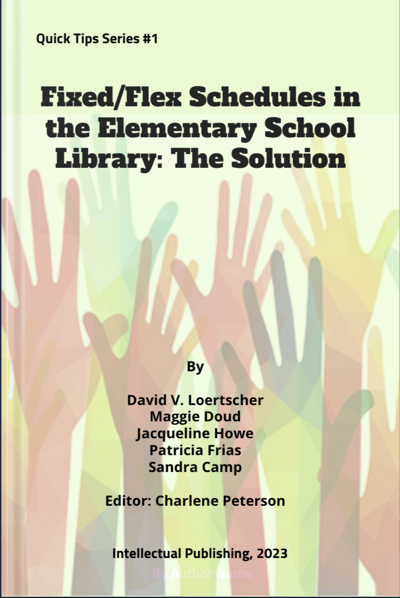
By Dr. David Loertscher
Have you encountered a pesky problem needing a solution but nothing seems to come over time? We often wish for that Aha! moment that makes us think: “I wonder if… Suppose we…” solution that just might work. This happened in a graduate instructional design class I teach at San Jose State University. As a group, we had encountered the software program Book Creator that made it so easy to write and publish an idea that small groups each took on a problem to solve and write about. Four students, my able graduate assistant, Charlene Peterson, and I decided to confront a pesky problem of the fixed and flex schedule controversy of the elementary school library.
For over sixty years of my experience, school librarians have tried to convince the world that a fixed schedule should be replaced by a flexible learning commons experience. Our arguments have been like beating a drum in a forest that has no ears. Perhaps we should beat our drum a bit louder hoping for a different result. Sadly no one has listened because the needs of the organization to provide teachers planning time overshadow our need to use flex time to coteach and partner with our colleagues in creating deep learning experiences.
The result of our effort is our eBook that you can read at: Fixed/Flex Schedules in the Elementary School Library: The Solution
When you publish using Book Creator, the program counts the number of readers that peruse your work. In our case, in the first couple of weeks, over a thousand readers from across the world took a look. Perhaps you could join them.
We attack the idea of “either / or” fixed vs. flex with a “both / and” solution. We begin with the audacity to propose that if you are required to be in the learning commons once a week, that this time should be under the control of each learner. It becomes “My Time” or a chance to learn what I want to learn and to create. It takes note of a current trend to provide learners with an innovation lab that is larger in scope than just a makerspace. My Time requires little adult supervision and allows the teacher librarian more time to partner with classroom teachers in the important mission of the new Canadian standards.
Curious? We hope so. Please take a peek. Do a test run. Have a conversation with colleagues. Correspond with David Loertscher at reader.david@gmail.com or Charlene Peterson at charlene.peterson@sjsu.edu. We’d love your feedback. Like the picture on the cover of the book, it just might be learners who win the argument and raise their hands in celebration.
Dr. David Loertscher has degrees from the University of Utah, the University of Washington and a Ph.D. from Indiana University. He has been a school library media specialist in Nevada and Idaho at both the elementary and secondary school levels. He has taught at Purdue University, The University of Arkansas, The University of Oklahoma, and is presently a professor at the School of Library and Information Science at San Jose State University. He served as head of the editorial department at Libraries Unlimited for ten years and is President of Hi Willow Research & Publishing LMC Source. He has been a president of the American Association of School Librarians. Email him at: reader.david@gmail.com.
